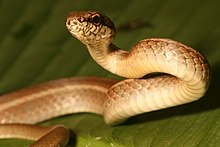Genus of snakes
Mastigodryas is a genus of colubrid snakes. Like some other colubrids, they are commonly called racers. It is a Neotropical genus, with members distributed from Mexico to Argentina and several islands in the Caribbean. Some authorities use the older generic name, Dryadophis, for these species.[1]
Description
These snakes are cylindrical or somewhat laterally compressed in shape. The head is distinct from the rest of the body, as in many other colubrids. They have large eyes. They have Duvernoy's glands.[1] The morphology of the hemipenis in various species has been helpful in elucidating their relationships, as little is known about the evolutionary origins of the genus.[2]
Behavior
These snakes are diurnal[1] and actively forage for their prey.
Diet
The diet is varied. For example, Mastigodryas bifossatus is euryphagic, consuming a wide variety of prey items. A large part of its diet is made up of frogs, and it will also take various mammals, birds, lizards, and other snakes.[3]
Species
There are 13[1][4] species. There may be as many as 18 if certain subspecies are elevated to species status, as has been suggested.[5]
Species include:[2][6]
- Mastigodryas alternatus (Bocourt, 1884)
- Mastigodryas amarali (L.C. Stuart, 1938) – Amaral's tropical racer
- Mastigodryas boddaerti (Sentzen, 1796) – Boddaert's tropical racer
- Mastigodryas bruesi Barbour, 1914 – Barbour's tropical racer
- Mastigodryas cliftoni (Hardy, 1964) – Clifton’s lizard eater
- Mastigodryas danieli Amaral, 1935 – Daniel's tropical racer
- Mastigodryas dorsalis (Bocourt, 1890) – striped lizard eater
- Mastigodryas heathii (Cope, 1876) – Heath's tropical racer
- Mastigodryas melanolomus (Cope, 1868) – salmon-bellied racer
- Mastigodryas moratoi Montingelli & Zaher, 2011[7]
- Mastigodryas pleii (A.M.C. Duméril, Bibron & A.H.A. Duméril, 1854) – Plee's tropical racer
- Mastigodryas pulchriceps (Cope, 1868) – Cope's tropical racer
- Mastigodryas reticulatus (W. Peters, 1863)[8]
Nota bene: A binomial authority in parentheses indicates that the species was originally described in a genus other than Mastigodryas.
References
- ^ a b c d Savage JM (2002). The Amphibians and Reptiles of Costa Rica: A Herpetofauna Between Two Continents, Between Two Seas. Chicago: University of Chicago Press. p. 673.
- ^ a b Jadin, Robert C.; Parkhill, Richard V. (2011). "Hemipenis descriptions of Mastigodryas (Serpentes: Colubrinae) from northern Middle America, with comments on the use of hemipenial data in phylogenetics". Herpetology Notes 4: 207-210.
- ^ Marques OAV, Muriel AP (2007). "Reproductive biology and food habits of the swamp racer Mastigodryas bifossatus from southeastern South America".The Herpetological Journal 17 (2): 104-109.
- ^ Mendoza, R. Juan Salvador; Rodríguez, S. Natalia (2010). "Observations on some aspects of the predatory behavior of the diurnal snake Mastigodryas pleei (Duméril, Bibron and Duméril 1854) held in natural and captive conditions". Archived 2016-03-04 at the Wayback Machine Rev. Colombiana Cienc. Anim. 2 (2): 253-263.
- ^ Montingelli GG (2009). Revisão taxonômica do gênero Mastigodryas Amaral, 1934 (Serpentes: Colubridae). Thesis. São Paulo: Instituto de Biociências. (in Portuguese, with an abstract in English).
- ^ Mastigodryas Amaral, 1934. The Global Biodiversity Information Facility (GBIF). 2010.
- ^ Montingelli GG, Zaher H (2011). "New species of Mastigodryas Amaral, 1934 from Brazilian Amazonia and Guyana (Serpentes: Colubridae)". Journal of Herpetology 45 (1): 111-119.
- ^ Montingelli GG et al. (2011). "Revalidation of Herpetodryas reticulata (Peters, 1863) (Serpentes: Colubridae) from Ecuador".South American Journal of Herpetology 6 (3): 189-197. Archived 2016-03-03 at the Wayback Machine
Further reading
